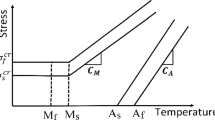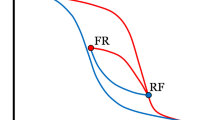Abstract
The superelasticity of shape memory alloys is a characteristic that permits to this smart material to dissipate significant energy during dynamic loads in addition to having the capacity to be used for seismic attenuation. Experimental studies have shown the strain rate and the cyclic loading caused by an earthquake influence on the residual strain and transformation stress of shape memory alloys. For this reason, this work consists of introducing the influence of the two latter parameters on constitutive laws of the most used shape memory alloy in the civil engineering field. A numerical model is then proposed and validated, and it represents residual strain–cyclic load and transformation stress–cyclic load relationships. A comparison between the original model, the built model and the experimental results is presented to show the consequence of taking into account the strain rate and cyclic loading effects. Finally, a parametric study is carried out to show cycles to be experimentally determined to get significant numerical results.










Similar content being viewed by others
Availability of data and material
Not applicable.
Code availability
Not applicable.
References
Asgarian B, Salari N, Saadati B (2016) Application of intelligent passive devices based on shape memory alloys in seismic control of structures. Structures 5:161–169. https://doi.org/10.1016/j.istruc.2015.10.013
Auricchio F, Sacco E (1997) A one-dimensional model for superelastic shape-memory alloys with different elastic properties between austenite and martensite. Int J Non-Linear Mech 32(6):1101–1114. https://doi.org/10.1016/S0020-7462(96)00130-8
Auricchio F, Fugazza D, Desroches R (2008) Rate-dependent thermo-mechanical modelling of superelastic shape-memory alloys for seismic applications. J Intell Mater Syst Struct 19(1):47–61. https://doi.org/10.1177/1045389X06073426
Bernardini D, Brancaleoni F (1999) Shape memory alloys modelling for seismic applications. In: Atti del MANSIDE project—final workshop—memory alloys for new seismic isolation and energy dissipation devices, pp 73–84
Zhou Bo, Liu Y, Jinsong L, Zou GP (2009) A macro-mechanical constitutive model of shape memory alloys. Sci China Ser G Phys Mech Astron 52(9):1382–1391
Brinson LC (1993) One-dimensional constitutive behavior of shape memory alloys: thermomechanical derivation with non-constant material functions and redefined martensite internal variable. J Intell Mater Syst Struct 4(2):229–242
Brinson LC, Huang MS (1996) Simplifications and comparisons of shape memory alloy constitutive models. J Intell Mater Syst Struct 7(1):108–114. https://doi.org/10.1177/1045389X9600700112
Casciati F, Faravelli L (2009) A passive control device with SMA components: from the prototype to the model. Struct Control Health Monit 16(7–8):751–765. https://doi.org/10.1002/stc.328
Casciati F, Faravelli L, Al Saleh R (2009) An SMA passive device proposed within the highway bridge benchmark. Struct Control Health Monit 16(6):657–667
Casciati F, Faravelli L, Hamdaoui K (2007) Performance of a base isolator with shape memory alloy bars. Earthq Eng Eng Vib 6(4):401–408. https://doi.org/10.1007/s11803-007-0787-2
Desroches R, Delemont M (2002) Seismic retrofit of simply supported bridges using shape memory alloys. Eng Struct 24:325–332
Dezfuli HF, Alam MS (2013) Shape memory alloy wire-based smart natural rubber bearing. Smart Mater Struct. https://doi.org/10.1088/0964-1726/22/4/045013
Hamdaoui K (2020) State-of-the-art: shape memory alloys for monumental consolidation and base isolation. Int J Sustain Mater Struct Syst 4(2–4):131–147. https://doi.org/10.1504/IJSMSS.2020.109080
Hamdaoui K, Benadla Z (2014) Dynamic analysis of a historical monument: retrofit using shape memory alloy wires. Smart Struct Syst 13(3):375–388. https://doi.org/10.12989/sss.2014.13.3.375
Hamdaoui K, Benadla Z, Chitaoui H, Benallal ME (2019) Dynamic behavior of a seven-century historical monument reinforced by shape memory alloy wires. Smart Struct Syst 23(4):337–345. https://doi.org/10.12989/sss.2019.23.4.337
Jha VK, Mahapatra RD (2009) Constitutive modeling of shape memory alloy wire with non-local rate kinetics. Contin Mech Thermodyn 21:1–15. https://doi.org/10.1007/s00161-009-0091-7
KanYu QC, Kang G, Li J, Yan W (2016) Experimental observations on rate-dependent cyclic deformation of super-Elastic NiTi shape memory alloy. Mech Mater 97:48–58. https://doi.org/10.1016/j.mechmat.2016.02.011
Liang C, Rogers CA (1990) One-dimensional thermomechanical constitutive relations for shape memory materials. J Intell Mater Syst Struct 1(2):207–234. https://doi.org/10.1177/1045389X9000100205
Lobo PS, Almeida J, Guerreiro L (2015) Shape memory alloys behaviour : a review. Proc Eng 114:776–783. https://doi.org/10.1016/j.proeng.2015.08.025
Prahlad H, Chopra I (2001) Comparative evaluation of shape memory alloy constitutive models with experimental data. J Intell Mater Syst Struct 12(6):383–395. https://doi.org/10.1106/104538902022599
Sayyaadi H, Zakerzadeh MR, Salehi H (2012) A comparative analysis of some one-dimensional shape memory alloy constitutive models based on experimental tests. Sci Iran 19(2):249–257. https://doi.org/10.1016/j.scient.2012.01.005
Tanaka K, Kobayashi S, Sato Y (1986) Thermomechanics of transformation pseudoelasticity and shape memory effect in alloys. Int J Plast 2:59–72
Torra V, Auguet C, Isalgue A, Carreras G, Terriault P, Lovey FC (2013) Built in dampers for stayed cables in bridges via SMA. The SMARTeR-ESF project: a mesoscopic and macroscopic experimental analysis with numerical simulations. Eng Struct 49:43–57. https://doi.org/10.1016/j.engstruct.2012.11.011
Acknowledgements
The authors are thankful to Prof. Abdellatif Megnounif and Prof. Nadir Boumechra, University of Tlemcen, for their support, guidance and valuable comments during the development of this research.
Funding
Not applicable.
Author information
Authors and Affiliations
Corresponding author
Ethics declarations
Conflict of interest
Not applicable.
Rights and permissions
About this article
Cite this article
Benkraled, M.I., Benadla, Z. Introduction of the strain rate and cyclic loading effects on shape memory alloys constitutive law models. Innov. Infrastruct. Solut. 6, 64 (2021). https://doi.org/10.1007/s41062-020-00412-w
Received:
Accepted:
Published:
DOI: https://doi.org/10.1007/s41062-020-00412-w




